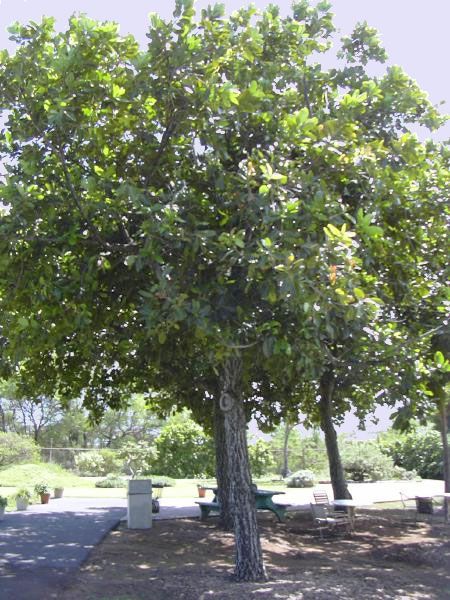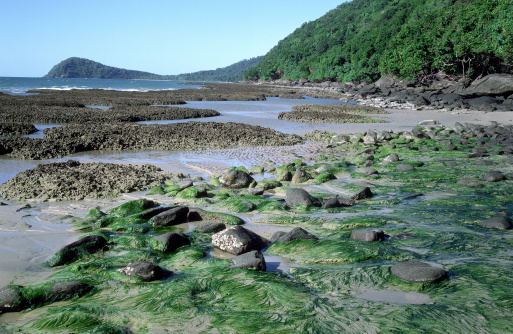Fringing reef
“Where the Rainforest meets the Sea” is the sobriquet of the Daintree World Heritage Area – this is one of the few places in the world where there is a fringing reef off a continental land mass. Unfortunately we are just becoming aware of our fringing reefs. They have been a neglected reef structure due to their lack of brilliancy and diversity compared to the outer reefs (at least now). Visitors come and want to snorkel the fringing reefs, but tend to be put off due to horror tales spouted by tour bus drivers regarding crocodiles and stingers – all about to chomp the unwary visitor. As long as you check which beach is croc safe and wear a stinger suit in season you can be worry free! Those brave enough to venture in sometimes discover visibility to be one finger’s length in front of them and emerge disheartened. However, on a clear day, having had no wind for several days, the water is clear and the reefs are well worth a visit to see the abundance of life from turtles, coral, fish and lots of other interesting things – all for free only 100 meters off shore – and all for free!
However, at least for this section of coast, the future looks grim. Visitors are confronted with masses of ugly black rocky outcrops, which were once coral reef, but are now covered with slimy algae and little else.

We are starting to get an understanding of why this might be so.
We have a problem with excess nutrients, not so much from local sources
(although Council’s obsessive roadside spraying isn’t
helping!), but mostly from nutrients travelling up the coast from the
agricultural areas of Gladstone and Mackay. Prawn trawling appears to
also be an issue, creating large amounts of sediment, which is carried
inshore. There also appears to be another reason - behind Cape
Tribulation is the coastal range – a granite intrusion into the
surrounding ‘country’ rocks. The metamorphosed country
rocks have eroded away, and the granite core is now exposed. As a
result that area has become lighter, and is lifting like a cork, which
causes the land to rise (uplift). This uplift appears to be very fast
at the moment. We have Calophylum trees (Calophylum inophylum)which
typically grow at the high tide boundary. These can become massive
trees overhanging the beach. A particularly spectacular example is at
the northern end of Cape Tribulation Beach. However, we have found
these trees over 100 meters inland, leaning over a long gone high tide
mark, and they’re still alive!

Many of our coastal forests are in fact developing on sand (S Noah beach) – and may only be a thousand or so years old.
So, the fringing reef is being pushed up – and corals do not tolerate much exposure to air, so they die.
The next issue is overgrowth of algae, primarily Sargassum, which totally prevents coral recruitment, and shades the corals, which require some sunlight for the zooxanthellae in their tissues, to photosynthesise. Sediment is the worst enemy of corals, to some degree they can get rid of it (by producing mucous) but there is a point at where they are overwhelmed.
Sargassum is a true ‘weed’ of the fringing reefs, there are other algae that can be destructive but Sargassum creates fields of blanketing growth. In order to support its growth it depends on sufficient sedimentation.
Once Sargassum finds a toehold on a big Porites bommie, it can, in time, kill it by smothering. Lack of herbivorous fish (the fringing reefs seem fish poor compared with the outer reefs) contribute, see F Rohwer and M Youle “Coral Reefs in the Microbial Seas” for an excellent discussion of this (Link Here). Sargassum also acts like a ‘micro-fibre’ dust cloth – accumulating particulate matter and holding it during calm conditions, releasing it when the wave action increases – this causes abrupt changes in turbidity. Just shake a Sargassum frond and see what comes off!

Fringing reefs near Cape Tribulation (1986)
The dark seaward areas are coral, immediately inshore of this is Sagassum then remnant upraised reef or sandy flats. The area outlined in red is the Research Station site – we hadn’t moved in or started planting then. The clearing dates from 1970.
Once you get past the Sagassum we start to see real coral assemblages - massive porites bommies, various forms of staghorn and plate corals, brain corals and their ilk, and their relatives the hydroids and fan corals. Sponges seem to be mostly encrusting species, and there seems a paucity of nudibranchs and starfish. There are reef building algae as well, these have calcareous material in their ‘leaves’ and contribute to reef formation.
Plate corals (Montipora sp) appear to be the dominant coral form on many of the fringing reefs.
Christmas Tree worms (Spirobranchus) burrow into massive corals (especially Porites) – and poke out their feeding tentacles. They are less common than on the main reef.
Ostrich plume hydroids (feather hydroids) (Plumularia) – look a bit like Sargassum until you look closely. Don’t touch... they sting!
Our big problem is that we have no photographic records of the fringing reef before 1990. So we are rather left in the dark about the changes that have occurred, especially the impact of the construction of the Cape Tribulation to Bloomfield Road 1984-1988 (Daintree Blockade ).
We are hoping that the rate of land rise here (uplift) is greater than or equal to the projected sea level rise due to Global Warming!
Projects
We’d love to have someone interested in long term measurements of the changes in areal distribution of Sargassum over time, and changes in the water quality of the ocean on the coast
http://austrop.org.au © 1988 - 2015 - Charter - tibobruss.fr


